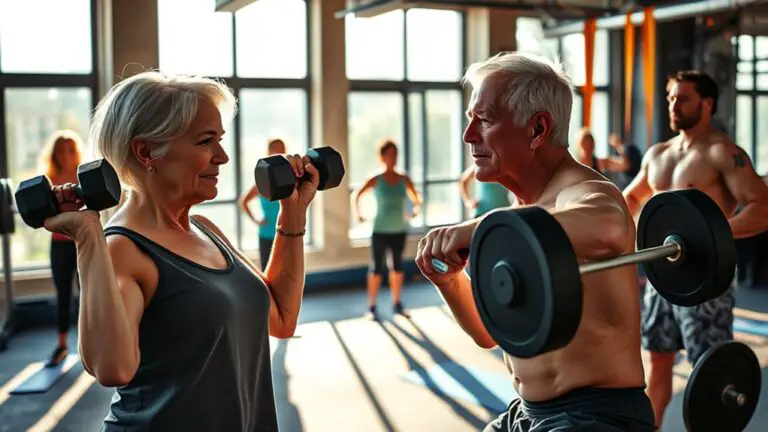The Best Strength Training Exercises for Boxers

Strength training is essential for boxers looking to boost their power and performance. Focus on squat variations for explosive leg strength, deadlifts for overall body strength, and bench presses to develop upper body power. Pull-ups will build back and arm strength, while medicine ball throws enhance explosiveness. Don’t forget core exercises like planks and Russian twists for better stability. Incorporating plyometrics will also improve your speed and agility. Keep exploring to discover additional tips for maximizing your training!
The Importance of Strength Training in Boxing

While many people might focus on speed and agility in boxing, strength training is equally crucial for any serious boxer. Building strength not only enhances your punching power but also provides numerous strength benefits that can elevate your overall performance in the ring. With increased muscle mass, you’ll notice improved endurance, allowing you to maintain your energy throughout longer bouts.
Moreover, strength training plays an essential role in injury prevention. A well-structured strength program helps fortify your muscles, ligaments, and tendons, making them more resilient against the strains of intense training and competition. It also aids in correcting muscle imbalances that could lead to injuries. Additionally, incorporating exercises such as jumping rope into your regimen can further improve your overall conditioning and coordination, which are vital for success in boxing.
Incorporating strength exercises into your routine guarantees you’re not just quick and agile but also physically robust, setting the stage for success in your boxing journey. So, don’t underestimate the power of strength training; it’s a game-changer for any boxer aiming for excellence.
Squats: Building Leg Power
Strength training isn’t just about upper body power; building leg strength is essential for any boxer aiming to improve performance in the ring. Strong legs provide the foundation for explosive movements, balance, and overall power. Incorporating squat variations into your training routine can help you achieve this.
Building leg strength is crucial for boxers, enhancing explosive movements, balance, and overall performance in the ring.
Here are four effective squat variations to boost your leg strength:
- Bodyweight Squats: Great for beginners, these help perfect your form.
- Goblet Squats: Holding a dumbbell or kettlebell adds resistance, enhancing strength.
- Bulgarian Split Squats: This unilateral movement targets each leg individually, improving balance.
- Jump Squats: Incorporating explosive jumps builds power, vital for quick footwork in the ring.
Additionally, exercises like the Goblet squat can be beneficial for developing mobility and strength while minimizing knee strain.
Deadlifts: Enhancing Overall Strength

If you want to enhance your overall strength for boxing, incorporating deadlifts into your training routine can be a game changer. Deadlifts target multiple muscle groups, making them vital for building a solid foundation. By engaging your legs, back, and core, you’ll develop the power necessary for explosive movements in the ring.
Mix in deadlift variations, like sumo or Romanian deadlifts, to keep your workouts fresh and target different muscles. These variations can also help improve your grip strength, which is essential for maintaining control during exchanges. A strong grip not only supports your punches but also aids in clinching and grappling situations.
Aim for proper form to maximize benefits and reduce injury risk. Start with moderate weights, gradually increasing as you gain confidence. Incorporating deadlifts into your regimen will enhance your overall strength, giving you the edge you need to excel in boxing.
Bench Press: Developing Upper Body Power
The bench press is a key exercise for building upper body power, essential for your performance in the ring. By focusing on proper muscle engagement techniques, you can maximize your strength gains. Additionally, understanding the ideal rep ranges will help you tailor your training for explosive power and endurance.
Muscle Engagement Techniques
While many boxers focus on agility and speed, developing upper body power through techniques like the bench press can greatly enhance your performance in the ring. To maximize muscle activation and improve neuromuscular coordination, consider these engagement techniques:
- Proper Grip: Use a grip that feels comfortable, ensuring you’re targeting the right muscles.
- Controlled Descent: Lower the bar slowly to engage your chest and shoulders fully.
- Explosive Lift: Push the bar up quickly to build power, mimicking the force needed in punches.
- Focus on Breathing: Inhale during the descent and exhale explosively while lifting, enhancing core stability.
Incorporating these techniques will help you develop the upper body power essential for boxing success.
Optimal Rep Ranges
To build upper body power effectively, understanding ideal rep ranges for the bench press is essential. Generally, for power development, you’ll want to focus on lower rep ranges—typically between 3 to 6 reps per set. This approach allows you to lift heavier weights, stimulating maximal strength gains. As you incorporate training periodization, consider alternating between phases of heavier, lower-rep training and lighter, higher-rep work to promote muscle endurance. This not only enhances your pressing power but also keeps your training fresh and prevents plateaus. Remember, consistency is vital, so track your progress and adjust your rep ranges as needed to guarantee you’re continually challenging your muscles and pushing your limits.
Pull-Ups: Strengthening the Back and Arms

Pull-ups are one of the best exercises for building strength in your back and arms, essential for any boxer. Mastering proper form not only maximizes the benefits but also helps prevent injuries. Let’s explore how incorporating pull-ups into your routine can elevate your performance in the ring.
Benefits of Pull-Ups
One of the most effective bodyweight exercises for building upper body strength is the pull-up. Not only does it target your back and arms, but it also offers several key benefits for boxers:
- Improved Grip Strength: Essential for maintaining control during a fight.
- Core Stability: Engaging your core helps with overall balance and power.
- Versatile Pull-Up Variations: Options like chin-ups or wide-grip pull-ups keep your workouts fresh and challenging.
- Functional Strength: Enhances your ability to perform explosive movements in the ring.
Incorporating pull-ups into your training regimen can greatly boost your performance and help you build the strength needed to excel in boxing. So, grab that bar and start pulling your way to better strength!
Proper Form Techniques
While mastering pull-ups can seem challenging at first, using proper form is vital for maximizing their effectiveness in strengthening your back and arms. Start by gripping the bar with a proper stance—hands shoulder-width apart and palms facing away. As you pull yourself up, engage your back muscles and keep your shoulders down to avoid strain. Remember to maintain a straight body line; avoid swinging or using momentum. Breathing techniques are also important—exhale as you pull up and inhale on your way down. This rhythm not only helps with endurance but also keeps your movements controlled. Practicing these elements consistently will enhance your pull-up performance, ensuring you build strength efficiently and safely.
Medicine Ball Throws: Improving Explosiveness
When you’re looking to boost your explosiveness in the ring, incorporating medicine ball throws into your training routine can make a significant difference. These exercises enhance your explosive power, helping you deliver stronger punches and improve overall performance. Here are four effective medicine ball throw variations to try:
Boost your explosiveness in the ring with medicine ball throws to enhance power and performance.
- Chest Pass: Stand with your feet shoulder-width apart, throw the ball forcefully from your chest, and catch it on the rebound.
- Overhead Throw: Raise the ball above your head and throw it downwards, engaging your legs and core for maximum force.
- Rotational Throw: Stand sideways to a wall, twist your torso, and throw the ball against it, focusing on your hip and core movement.
- Slams: Lift the ball overhead and slam it down as hard as you can, using your entire body for power.
Incorporate these into your workouts, and watch your explosiveness soar!
Core Exercises: Stabilizing for Better Performance

To enhance your performance in the ring, it’s vital to focus on core exercises that stabilize your body and improve your overall strength. A strong core not only supports your movements but also enhances your ability to absorb and deliver punches. Incorporating exercises like planks and Russian twists helps develop core stability, allowing you to maintain balance during intense bouts.
For effective training, include rotational movements, such as medicine ball slams and cable woodchoppers. These exercises promote core rotation, which is essential for generating power in your punches and improving your footwork. Don’t overlook the importance of stability; engaging your core while performing other exercises can elevate your performance considerably. Additionally, incorporating jump rope into your routine can improve coordination and balance, further enhancing your agility in the ring.
Plyometrics: Boosting Speed and Agility
Incorporating plyometric exercises into your training regimen can greatly enhance your speed and agility, crucial components for any boxer. These explosive movements improve your quickness and overall performance. Here are four effective plyometric drills to try:
Enhance your boxing performance with plyometric exercises that boost speed and agility for quicker movements in the ring.
- Box Jumps: Propel yourself onto a sturdy box to build leg power and explosiveness.
- Plyometric Push-Ups: Push off the ground with enough force to lift your hands, increasing upper body strength and speed.
- Agility Ladders: Use agility ladders to work on foot speed and coordination, essential for dodging and weaving.
- Depth Jumps: Step off a box and explode upwards upon landing, enhancing reactive strength.
Incorporate these drills into your routine, and you’ll notice improved agility and faster movement in the ring. Remember, consistency is key to maximizing your results!
Frequently Asked Questions
How Often Should Boxers Incorporate Strength Training Into Their Routine?
You should aim to incorporate strength training into your routine about two to three times a week. This frequency allows you to build muscle while also giving your body time to recover, which is essential for preventing injuries and maximizing performance. Remember, balancing strength work with technique and conditioning is key. Listen to your body; if you’re feeling fatigued, don’t hesitate to adjust your schedule to prioritize recovery.
What Should Boxers Eat to Support Strength Training Goals?
Picture your plate filled with vibrant veggies, lean proteins, and whole grains, fueling your strength training journey. To support your goals, focus on meal timing; consume a balanced meal with the right nutrient ratios—carbs for energy, proteins for muscle repair, and healthy fats for overall health. Aim to eat a mix of these nutrients before and after workouts, ensuring your body’s ready to push through and recover effectively.
Can Strength Training Help Prevent Injuries in Boxing?
Yes, strength training can definitely help prevent injuries in boxing. By building muscle strength and stability, you’re not only enhancing your overall boxing performance but also reducing the risk of common injuries. Stronger muscles support your joints and improve your balance, which is essential during intense training and matches. Incorporating targeted strength exercises into your routine will help you stay strong, agile, and less prone to injuries, allowing you to perform at your best.
How Do I Balance Strength Training With Boxing Practice?
Balancing strength training with boxing practice isn’t just about time management; it’s about integrating techniques that enhance your performance. You’ll want to focus on strength training techniques that complement your boxing skills, building power without sacrificing speed. Prioritize short, intense workouts for strength and maintain your boxing endurance balance with regular sparring sessions. By alternating between these elements, you can optimize your training, prevent injury, and guarantee you’re always ready for the ring.
Are There Specific Supplements Recommended for Boxers Focused on Strength?
If you’re focused on strength, you might consider protein powders to support muscle recovery and growth. Creatine monohydrate can enhance your strength and power during training. Don’t overlook recovery supplements, as they can help reduce muscle soreness after intense workouts. Additionally, amino acids play an essential role in muscle repair and performance. Always consult with a nutritionist to personalize your supplement plan and guarantee it aligns with your training needs.





